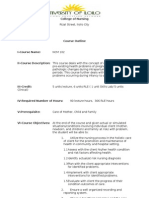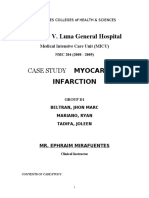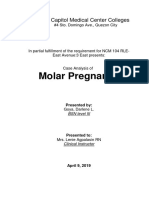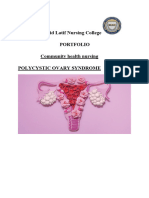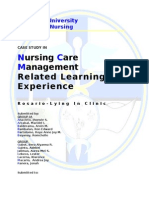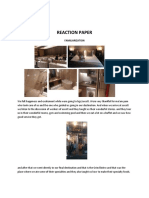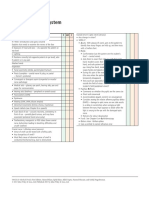Case Study Myoma 150904183220 Lva1 App6892
Case Study Myoma 150904183220 Lva1 App6892
Uploaded by
Crystal JadeCopyright:
Available Formats
Case Study Myoma 150904183220 Lva1 App6892
Case Study Myoma 150904183220 Lva1 App6892
Uploaded by
Crystal JadeOriginal Description:
Original Title
Copyright
Available Formats
Share this document
Did you find this document useful?
Is this content inappropriate?
Copyright:
Available Formats
Case Study Myoma 150904183220 Lva1 App6892
Case Study Myoma 150904183220 Lva1 App6892
Uploaded by
Crystal JadeCopyright:
Available Formats
PERPETUAL HELP COLLEGE OF MANILA
1240 V. Concepcion St., Sampaloc, Manila
Submitted to:
Mrs. Josephine Dela Cruz, RN
Clinical Instructor
Submitted by:
Abordo, Nena Bell Jill - Physical Assessment & Nursing Care Plan
Alpecho, Kathreen Mae - Drug Study
Alunday, Radigundee - Medical and Surgical Management
Awat, Cassandra Von - Etiology or Risk Factors
Barzaga, Cristine - Diagnostic Procedure
Cabarrubias, Alvin Ray D. -Gordon’s Health Pattern, Pathophysiology,
Statement of Nursing Diagnosis & Nursing Care Plan
Canlas, Veronica - General Objectives, Nursing Care Plan & Discharge Plan
Changco, Mariaelis - Anatomy & Physiology
Commendador, Maritonee - Client’s Data & Health History
Corpuz, Nichael Bonn - Introduction
1
PERPETUAL HELP COLLEGE OF MANILA
Format for Case Presentation
I. Client’s Data
II. Health History
• Family Health History
i. Maternal Health History
ii. Paternal Health History
• History of Past and Present Illness
• Risk Factors Associated with Disease
i. Non- modifiable Factors
ii. Modifiable Factors
III. Physical Assessment
• Subjective- Gordon’s Health Pattern
• Objective- Kozier’s reference
IV. Definition of Disease/Introduction
V. Pathophysiology of the Disease
VI. Anatomy and Physiology
VII. Diagnostic Procedures done to Client
VIII. Medical/Surgical Management done
IX. Drug Study
X. Statement of nursing problems/nursing diagnosis based on grouped data(Gordon’s)
XI. Priority Nursing Problem/Nursing Care Plan
• Actual
• Potential
XII. Discharge Plan
2
PERPETUAL HELP COLLEGE OF MANILA
Table of Contents
I. Client’s Data………………………………………….………..… 1
II. Health History…………………………………………………… 2
• Family Health History…………………………………………… 2
iii. Maternal Health History…………………………….. 2
iv. Paternal Health History……………………………… 2
• History of Past and Present Illness………………….…....… 2
• Risk Factors Associated with Disease……………………… 3
iii. Non- modifiable Factors……………………………… 3
iv. Modifiable Factors…………………………………….. 3
III. Physical Assessment……………………………………………. 5
• Subjective- Gordon’s Health Pattern……………………….. 5
• Objective- Kozier’s reference…………….……………..…… 9
IV. Definition of Disease/Introduction…………………..…… 32
V. Pathophysiology of the Disease……………………………… 33
VI. Anatomy and Physiology……………………………….………. 34
VII. Diagnostic Procedures done to Client………………….…. 41
VIII. Medical/Surgical Management done……………….………. 46
IX. Drug Study………………………………………….……………. 50
X. Statement of nursing problems/nursing diagnosis
based on grouped data(Gordon’s)…………………...………. 62
XI. Priority Nursing Problem/Nursing Care Plan………...…... 63
• Actual
• Potential
XII. Discharge Plan…………………………………………………… 64
3
General Objectives:
This study on myoma aims to look into the indispensible information
regarding the disease, its pathophysiology resulting to the theoretical
signs and symptoms and correlate them with those manifested by the
patient
It is also aims to develop our skills, knowledge and attitude in providing
proper nursing care needed to have an effective nursing management and
list the criteria used for diagnosing myoma
Develop good Nurse-Patient relationship
Specific Objectives:
In order to meet the general objective of the study, the ff intended to be done:
To be able to acquire knowledge regarding myoma through research
To be able to develop a better understanding on the use of medications
and its implication on the treatment of myoma
To be able to implement the appropriate plan of nursing management for
patients with myoma
4
I. Client’s Data
Name- De Luna, Rima Mejica
Age – 32
Chief complaint: VAGINAL BLEEDING
Diagnosis -AUB problem sec. to prolapsed submucosal myoma. G4P4
Time admitted – 6:10 PM
Ward- OB GYNE
Address- 417 NBB Navotas
B-day – 11/19/78
Religion- Roman Catholic
Father name- Loreto Dulay
Mother name- Crisanda Mejica
Husband name- Dante de Luna
Admitting physician – Dr. Macasadia
Pertinent physical findings:
BP 100/80 HR 89 RR 20 TEMP. 37
WT 44.5 kgs HT 1.43 BMI 21.76 kg/m2
Slightly pink palpebral conjunctivas SCF clear BS. A dynamic pericardium WRRR (-)
murmurs inspection + fleshy mass at introiter + moderate bleeding submucus. IE
10x5x5 cm prolapsing mass with stalked abnormal
Personal and social history:
Alcohol- occasional
B-GYNE history:
Menarche 15year old interval 28-30 duration 3days
5
Cornstarches 19 year old symptom- dysmenorrheal
OB score
G1 2000 male NSD del. Midwife (-) complication
G2 2006 female NSD del. Midwife (-) complication
G3 2007 preterm (7mos)
G4 2008 female NSD del. Midwife (-) complication
No. of sexual partner – 1 partner
Previous pap smear – NONE
Method of contraceptive (+) 2008 trust pills
6
II. Health History
•Family Health History
i. Maternal Health History
(+) hypertension
ii. Paternal Health History
(+) hypertension, (+) diabetes mellitus
•History of Past and Present Illness
2 months PTA patient noted increase menstruation duration and amount
for 5 days. No inter menstrual bleeding noted. 1 day PTA, patient while
strains during defecations. (+) bleeding during defecation. She strained and
noted prolapsed mass at urination and prompted consult.
• Risk Factors Associated with Disease
v. Non- modifiable Factors
-Anovulatory bleeding
-Midcycle bleeding associated with ovulation
-High levels of unopposed estrogen
vi. Modifiable Factors
-Complications of an early, undiagnosed pregnancy
-Breakthrough bleeding while they are taking oral
contraceptives
-Genetic abnormalities, race, and related to age of
menarche, obesity, and parity
7
• Classification of Myomas
1. Intramural. Found in the uterine wall, surrounded by myometrium. Clinical
manifestations include increased uterine size, vaginal bleeding between menses and
dysmennorrhea
2. Submucosal. Located directly under the endometrim, involving the endometrial cavity.
May become pedunculated (grow on a stalk). Clinical manifestations include prolonged
vaginal bleeding and cramps and the tumor may be seen protruding through the cervix.
3. Subserosal. Found on the outer surface (under the serosa) of the uterus. Tends to
become pedunculated, to wander, and to be multiple and large. Clinical manifestations
include backache, constipation and bladder problems.
4. Wandering or parasitic. A pedunculated leiomyoma that twists on its pedicle, breaks
off, then attaches to other tissues, particularly the omenum.
5. Intraligamentary. Implants on the pelvic ligaments. May be displace the uterus or
involve the ureters.
6. Cervical. Occur infrequently and may obstruct the cervical canal
8
III. Physical Assessment
• Subjective- Gordon’s Health Pattern
During
Health Before Hospitalization Hospitalization Analysis
Patterns
- Pt had abnormal uterine
bleeding for almost 4 days. - during her
Pt is a non smoker and a hospitalization,
occasional alcohol drinker. Pt she’s was rushed
have the family illness of to the emergency - She only
1. Health hypertension and diabetes. room & a vaginal seeks medical
perception - Mrs. D doesn’t have regular myomectomy was help whenever
Health medical check-ups and only done. after that needed.
management seeks medical attention when operation, she still The patient is
Pattern the need arises. Whenever feels weak anxious if the
she had headaches, she rest probably because fibroid is
for a while and take of losing too much cancerous or
paracetamol when needed. blood. She’s not.
Pt. perceived her menstrual anxious if the
cycle was regular until the mass that was
fourth day of excessive taken is
bleeding and presence of cancerous or not.
mass when she urinated.
- According to Mrs. D., she - Normal eating
eats three times a day. He pattern is at on
usually eats vegetables, fish the minimum of
and meat whenever they 3 times per
have extra money. The - during her day, depending
patient verbalized that she hospitalization, the upon metabolic
seldom eat fruits. doctor ordered need and
2. Nutritional In terms of fluid intake, the NPO until the third demands. Fluid
– Metabolic client stated that he day wherein she intake is on the
Pattern consumes at an average of was on soft diet. average of 8 to
5-6 glasses of water per day, 10 glasses per
distributed at around 2 day.
glasses in the morning, 3 at - She have to
noon and 1 glass at evening increase her
before hospitalization. She is fluid intake. In
9
the one who always prepare terms of her
their food. food intake and
frequency,
There are no
Patient’s WT 44.5 kgs HT remarkable
1.43 BMI 21.76 kg/m2 deviations
Normal BMI range:
<18.5…………...underweight
18.5-24.9………..healthy
25.0-29.9…………overweight
30≥……………………obesity
- During - Normal bowel
- Bowel Habits: Mrs. D hospitalization, movement is 1
defecates once a day with a since the patient to 3 times a
brownish stool. was on NPO, day and
3. Elimination Bladder Habits: She voids 3- there were voiding at 1200
Pattern 5 times a day with amber changes on her to 1500ml/day.
colored urine in small bowel and bladder - Mrs. D’s
amount. Pt urinates not more habits. She was bowel and
than 1000ml per void. on indwelling foley bladder habits
catheter. has changed
during
hospitalization.
- She stop taking - Well
- Mrs. D usually does walking walks during her described bout
when she gets bored before hospitalization her activities in
4. Activity her hospitalization. Pt is a because it is daily living like
Exercise housewife. She usually do contraindicated in exercising. She
Pattern household choirs and she’s operation is well informed
proud to say that it’s a good performed. that doing
form of exercising. So, she only do household
bed rest and tries choirs is a
to turn on each simple way of
side because she exercise.
always wake up.
5. Sleep – - before the Pt was - during her - Based from
Rest Pattern hospitalized, she mostly hospitalization, Kozier
10
sleep 7pm or 8pm at night The pt had stated Fundamentals
and wakes up at 8 in the that he of Nursing, 8-
morning. When she don’t experienced sleep 10 hours of
have anything to do after difficulties. She sleep is
lunch, he usually have a nap. always wake up in needed to have
different intervals. an adequate
Before going to rest and an
sleep she always environment
think about the that is
mass that was conducive to
taken out of her if health is
it’s benign or necessary to
malignant. provide comfort
to an individual.
- The client has
an abnormal
state of sleep
and rest.
Frequent
thinking about
her situation is
the primary
cause of sleep
deprivation.
- Patient does not have any - during her - There is no
hearing problems. hospitalization, symptoms of
She is oriented to time and there is no pain while we
place and can recall past significant change are doing an
events. Patient is a high in the status and interview.
school graduate. Mrs. D is perception of his
6. Cognitive- able to understand, and five senses.
perceptual communicate with others and
pattern make decisions on her own.
She is able to see, feel, hear,
smell, taste by testing him
like pinching, giving some
sentence to read and saying
words that she have to repeat
it after we said it.
7. Self- - Patient described herself as - during in her - pt is being a
perception a hardworking person. She hospitalization, positive thinker
and self claimed her happiness and she never think despite of what
11
concept contentment will be more felt negative things happened to
pattern if only his illnesses were that will make her her health
absent. Pt is contented to down while
have provided her family with recovering with
good life. her illness.
- Patient described himself as - during her - pt is still being
a loyal wife to her husband hospitalization, a good mother
as well a responsible mother her husband is to her kids
8. Role to her kids. Her husband aware of her despite of her
Relationship comes home every weekend current situation. current health
pattern from work as a contractual She is worried status.
carpenter. She takes care of about her kids if
her kids and do the cooking they’re doing well
and laundry form them. She without her. She is
send them to school also concerned if
everyday. they’re eating well.
- Patient had her 1st - during her - The Pt.
menstruation at the age of hospitalization, analyzed
15. She used to use pills she clearly clearly about it
9. Sexuality – Patient claims to have no describe the and able to
Reproductive history of STD or UTI. She patterns of understand the
pattern doesn’t have any problem satisfaction and physical and
with her sexual intercourse. dissatisfaction psychological
with sexuality. effects of his
current health
status on her
sexual
expression.
- Defines stress as something - during her - Able to
that can make someone tired. hospitalization, describe
Currently stressed because she doesn’t general coping
10.Coping of current physical condition. change her pattern and
and Stress Long term stressor include perception toward effectiveness of
Tolerance financial problems, and short her situation. the pattern in
term stressor include the She’s aware that terms of stress
problems in the community being hospitalized tolerance.
and family. Goes to is a stressful
neighbors and friends to situation. She tries
relieve stress and she shares to get well
her problem them. because she
Sometimes she brings her misses her kids.
12
kids to shopping malls to
stroll and in that way her
stress is relieved.
- Patient is a Roman Catholic - during her - able to
11.Value – and goes to church on hospitalization, determine the
Belief Pattern Sundays with her kids and there is no change patterns of
claims to pray everyday. She with her religious values and
values health life. She believes beliefs(spiritual)
and sees it as a wealth. God will help her or goals that
Patient does not have any recover faster guides his
superstitious beliefs. choices and
decisions.
.
• Objective- Kozier’s Reference
Vital signs
Normal Actual Analysis Interpretation
Vital signs Findings
On the disease
Blood process, any condition Cardiac output will often
pressure 120/80 160/90 that may affect the affect the delivery of oxygen
cardiac output, blood to the cells of the body and
volume, blood viscosity when the system or tissues
has direct effect on the does not get the required
blood pressure. oxygen for the metabolic
The patient was in process cellular function will
distress during the be altered.
assessment.
(Kozier, B. (2004).
13
Fundamentals of
Nursing p. 510).
Inflammation is a local,
nonspecific defensive Febrile
Temperature 36.5- 39.4 response of the tissues
37.5 to an injurious or The rate of loss depends
infectious agent. It is an primarily on the surface
adaptive mechanism temperature of the skin
that destroys or dilutes which is intern a function of
the injurious agent, skin blood flow. The blood
prevents further spread flow of the skin varies in
of the injury, and response to changes in the
promotes the repair of body core temperature and
damaged tissue. to changes in temperature
of the external environment.
Patient has an
increased WBC count
of 12.3% (August 23,
2010)
(Kozier, B. (2004).
Fundamentals of
Nursing p. 634).
Pulse wave represents the
Normal Range stroke volume output or the
Pulse rate 60-100 92 output or the amount for
(Kozier, B. (2004). blood that enters the
Fundamentals of arteries with each
Nursing p. 496). ventricular contraction.
Several factors that The effectiveness of
Respiratory 16-20 24 increase respiratory respiration is important for
14
rate rate include stress and the uptake of oxygen from
increase environmental the air into the blood and
temperature. release carbon dioxide from
the blood into expired air.
(Kozier, B. (2004).
Fundamentals of
Nursing p. 506).
Skin
PARTS METHOD NORMAL ACTUAL ANALYSIS INTERPRETATION
FINDINGS FINDINGS
Skin color
varies from Fair There is a The skin is dry and
Skin Inspection light to deep complexion decrease in flaky because
brown; from with dry and hemoglobin sebaceous and sweat
ruddy pink to flaky skin. because of glands are less active.
light pink, blood loss Dry skin is more
from yellow Pale in prominent over the
overtimes to appearance. extremities. Pallor is
olive. the result of
Generally inadequate circulating
uniform blood. Normal blood
except in No edema, circulation relies on
areas abrasions, muscle activity.
Palpation exposed to lesion. Immobility impedes
sun; areas of circulation and
lighter Temperature diminishes the supply
pigmentation is higher of nutrients to specific
(palms, lips than normal area. Pressure ulcers
15
nail beds) in range. are due to localized
dark skin ischemia, a deficiency
people. in the blood supply to
the tissue.
No edema, Generalized edema is
abrasions, most often an
lesion. indication of impaired
Temperature venous circulation and
is uniform in some cases reflects
and w/in cardiac dysfunction
normal range and venous
abnormalities.
Increase temperature
from the normal level
maybe due to tissue
destruction, pyrogenic
substances, or
dehydration on the
hypothalamus.
( Fundamentals of
Nursing by Kozier,
pp.529, 535,540,576,
1071)
Nails Inspection Convex Convex, Patient’s nail Pallor may reflect poor
curvature; smooth in beds are pale arterial circulation due
angle of nail texture, may be due to to diminished
plate about pallor, decreased circulating blood
160o capillary refill oxyhemoglobin volume.
- with smooth is 4-5 level on the
16
texture seconds on blood.
- color is the hands.
highly Nail bed (Fundamentals of
vascular& color is pale Nursing by Kozier,
pink in light on both p542)
skinned lower and
clients; dark upper
skinned extremities.
clients may
have brown
or black
pigmentation
in
longitudinal
streaks
with intact
epidermis on
tissue
surroundings
- blanch test-
prompt return
of pink or
usual color
(gen. <3 sec)
Head
NORMAL ACTUAL
PARTS METHOD FINDINGS FINDINGS ANALYSIS INTERPRETATION
Each hair
17
Hair Inspection Evenly Hair is black, grows from a Poor hygiene due
distributed hair thin and evenly single, live to impaired
over the scalp distributed over follicle has its physical mobility.
with thickness, the scalp. No own roots in The injury limits her
variable infection or the activities of daily
amount of infestation subcutaneous living. No
Palpation body hair. No noted. tissue of the significant relative
infection or It is dry and skin. Oil is there to help her
infestation. sticky. glands next to manage her poor
hair follicle hygiene.
provides gloss
and, to some
Scalp Inspection White, clean, Dry scalp. degree water
Normal Findings
free from Clean, free from proofing of the
masses, lumps masses, lumps hair.
Palpation scars, lice, nits, scars, lice, nits,
dandruff, and dandruff, and
lesions no area lesions no area (Kozier, B.
of tenderness of tenderness (2004).
Fundamentals
of Nursing p.
541)
Skull Inspection Rounded( Round Normal Normal findings
normocephalic) (normocephalic), findings
Palpation & symmetrical, smooth skull
with frontal, contour.
parietal, Smooth, (Fundamentals
occipital, absence of of Nursing by
prominences) nodules or Kozier page
smooth, masses. 544.)
18
uniform,
absence of
modules or
masses
Eyes
NORMAL ACTUAL
PARTS METHOD FINDINGS FINDINGS ANALYSIS INTERPRETATION
Eyebrows Inspection Symmetrically Symmetricall Normal
aligned. y aligned findings.
Equally and equal
distributed, movement. Normal findings
curled slightly Hair evenly (Kozier, B.
outward distributed. (2004).
Fundamentals
of Nursing p.
732).
Eyelashes Inspection Equally Eyelashes Normal
distributed, are equally findings.
Curled slightly distributed
outward and curled (Kozier, B. Normal findings
slightly (2004).
outward. Fundamentals
of Nursing p.
1152)
Eyelids Inspection The skin is Lids closes Normal Normal findings
intact, no symmetricall findings
19
discharge and y, bilateral
no blinking and
discoloration. no visible
The lids close sclera above
symmetrically corneas (Kozier, B.
blinks when lids (2004).
involuntary are open Fundamentals
and with of Nursing p.
bilateral 548
blinking.
Sclera & Inspection Shiny, smooth Pale Patient has Pallor may reflect
Conjunctiva
& pink or red conjunctiva, decreased poor arterial
in color smooth and hemoglobin circulation due to
shiny. level of 10.2 diminished
g/dl. circulating blood
(September 6, volume
2010)
(Kozier, B. (2004).
Fundamentals of
Nursing p. 554).
Cornea Inspection transparent, transparent, Normal Normal Findings
shiny & shiny & Findings
smooth, smooth,
details of the details of the
iris are visible iris are
visible
Pupils and Inspection Black in color, Iris black in Normal Normal findings
Iris equal in size, color, equal findings.
20
normally 3-7 in size and
mm in round in
diameter, shape. Iris is
sound- flat and
smooth border round. Pupil
iris flat & diameter is (Kozier, B.
sound. Pupils 3mm. (2004).
constrict when Pupils Fundamentals
looking at near constrict of Nursing p.
object and when light is 554).
dilate when directed
looking at far towards it,
objects. and dilate
when light is
removed.
Visual Inspection Able to read Able to read Normal Normal Findings
Acuity newsprint with newsprint Findings
20/20 vision with 20/20
on snellen vision on
chart. snellen
chart.
Ears
PARTS METHOD NORMAL ACTUAL ANALYSIS INTERPRETATION
FINDINGS FINDINGS
Auricles Inspection The color is Auricles Normal Normal Findings
the same as aligned at the Findings
21
facial skin, outer canthus
symmetrical, of the eyes,
the auricles symmetrical
aligned with and color is
outer canthus the same as
of the eye the facial skin.
Palpation
Mobile, firm
and not
tender, pinna
recoils after it
is folded.
Ear Inspection Distal third Distal third Normal Normal findings.
Canal contains hair contains hair findings.
follicles and follicles and
glands. Dry glands. Dry
cerumen, cerumen.
grayish-tan
color or sticky,
wet cerumen (Kozier, B.
in various (2004).
shades of Fundamentals
brown. of Nursing p.
556-557)
Hearing Inspection Normal voice Normal Voice Normal Normal findings
Acuity tones audible. tones audible. findings
Sound is
22
heard in both
ears or
localized at
the center of
the head According to
(Weber Kozier page
Negative). 597.
Air conducted
hearing is
greater than
bone
conducted
hearing
(positive
Rinne)
Nose
PARTS METHOD NORMAL ACTUAL ANALYSIS INTERPRETATION
FINDINGS FINDINGS
Nose Inspection Symmetric Symmetric and Normal Normal Findings
and straight straight Findings
No No discharge in
discharge in flaring
flaring Uniform in
Uniform in color
color Not tender, no
Not tender, lesion
23
no lesion
Facial Palpation No No tenderness Normal Normal findings.
Sinuses tenderness noted. findings
(Kozier, B.
(2004).
Fundamental
s of Nursing
p. 561)
Septum Inspection Air moves Nasal septum Normal Normal findings
freely as the intact and in findings
client midline.
breathes
through the
nares. Nasal
septum Kozier page
intact & in 560-561
midline
Mouth
PARTS METHOD NORMAL ACTUAL ANALYSIS INTERPRETATION
FINDINGS FINDINGS
Lips Inspection Uniform pink Pale, Dry Paleness is Blood loss decrease
Palpation color due to hemoglobin level and
Soft, moist, decrease in since the patient isn’t
24
smooth hemoglobin allowed to take any
texture and dry liquids
Symmetry of because of
contour dehydration
Ability to
purse lips
Buccal Inspection Uniform pink Presence of Immobility Foul breath odor is
mucosa color foul breath related to due to poor self
Soft, moist, odor. invasive hygiene and lack of
smooth procedure motivation from others
texture done
Gums Inspection Pink gums, Pinkish gums, Normal Normal findings.
moist, firm no retraction, findings.
texture to moist and firm.
gums. (Fundamental
s of Nursing
by Kozier,
p603)
Tongue Inspection Central Pink in color, Normal Normal Findings
Palpation position moist, no Findings
Pink color, lesions,
moist, tenderness and
slightly nodules.
rough; then, Tongue is on (Fundamental
whitish the middle. s of Nursing
25
coating Client was able by Kozier,
Smooth; to move tongue p603)
lateral from side to
margins; no side and up
lesions and down.
Raised
papillae
Moves
freely, no
tenderness
Smooth
tongue base
with
prominent
veins.
Teeth Inspection 32 adult Without Tooth loss Normal findings
teeth dentures and occurs as a
smooth, incomplete result of
white, shiny teeth, yellowish dental
tooth enamel in color with disease but is
pink gums pink gums. 4 preventable
moist. teeth on upper with good
and 7 on lower. dental
hygiene.
(Fundamental
s of Nursing
by Kozier
p566)
26
Uvula Inspection Soft, moist, Soft, moist, and Normal Normal findings.
smooth pink findings.
texture Pink
and smooth. (Fundamental
s of Nursing
by Kozier
p604)
Tonsils Inspection No No discharge. Normal Normal findings.
discharge. Pinkish in findings.
Tonsils of color. normal
normal size. size
Pink and (Fundamental
smooth s of Nursing
posterior by Kozier
wall. p604)
Neck
PARTS METHOD NORMAL ACTUAL ANALYSIS INTERPRETATION
FINDINGS FINDINGS
Neck Inspection Proportional Proportionate Muscles in Normal Findings
to size of the to the size of the neck like
head, head and sternocleido
symmetrical symmetrical. mastoid and
and straight. Unable to trapezius
Freely move. draw the
27
movable head to the
Palpation without side and
difficulty. elevate the
There are no chin and
No palpable palpable lymph elevate the
lumps or nodes. Head shoulders to
tenderness cannot easily shrug them.
The trachea flex and rotate. (Fundamental
is in the Trachea is in s of nursing
Central the central by Kozier p5)
placement in placement and
midline of no indication of
neck, spaces possible neck
are equal on tumor or
both sides. thyroid
enlargement.
Thorax
PARTS METHOD NORMAL ACTUAL ANALYSIS INTERPRETATI
FINDINGS FINDINGS ON
Chest
size and Inspection Anteroposterior Anteroposterior Normal Normal findings
shape to transverse to transverse in findings.
chest is ratio of 1:2,
symmetrical. chest is (Fundamentals
symmetrical of nursing by
Kozier p549)
28
Breath Auscultation Bronchovesicular Patient has a Normal Normal findings
sounds breathe sound. clear, Findings
bronchovesicular
breath sound. (Fundamentals
of Nursing by
Kozier p549)
Posterior Palpation Full and Full and Normal Normal findings
symmetric chest symmetric chest findings
expansion. expansion. Quiet
Premitus tactile and rhythmic,
most clearly at and effortless
the apex of the breathing.
lungs
Quiet, rhythmic
and effortless
respiration.
Vesicular and Resonant except
bronchovesicular on the scapula, (Fundamentals
Percussion breath sound. there is lowest of nursing by
point of Kozier p549)
Notes resonate, resonance over
except over scapula.
scapula, the
lowest point of
resonance is at
the diaphragm.
Anterior Inspection Quiet, rhythmic Effortless Normal Normal findings
and effortless Respiration. Findings
29
respiration.
Palpation Full and Full and (Fundamentals
symmetric chest symmetric chest of nursing by
expansion. expansion. Kozier p549
Same as box 29—5;
posterior vocal p617)
fremitus, fremitus
is normally
decreased over
heart and breast
tissue.
Breast
PARTS METHOD NORMAL ACTUAL ANALYSIS INTERPRETATIO
FINDINGS FINDINGS N
Breast Inspection No masses and n/a. The patient The patient
Palpation lumps refused to be refused to be
assessed assessed
Areola Inspection Dark in color in n/a The patient The patient
Palpation contrast to refused to be refused to be
surrounding skin. assessed assessed
No masses,
lumps and
lesions.
30
Nipples Inspection Size is n/a The patient
Palpation proportional. No refused to be
discharged or assessed
secretions.
Abdomen
PARTS METHOD NORMAL ACTUAL ANALYSIS INTERPREATTION
FINDINGS FINDINGS
Skin Inspection Unblemished Unblemished Normal Normal findings
integrity skin, uniform skin, uniform findings
in color. in color
According to
Kozier page
592-598
Contour Inspection Flat, Distended Abdomen is Uterine fibroids
and rounded. distended creates pressure to
Symmetry Symmetric due to the bladder and
contour. uterine rectum
fibroids
Movement Inspection Symmetric Symmetric Normal Normal findings
movements movement findings
caused by caused by
respiration. respiration,
no visible
31
vascular According to
pattern. Kozier page
592-598
Bowel Auscultation Audible Audible bowel Normal Normal Findings
sounds bowel sounds. Findings
sounds. hypoactive
Normal Bowel
bowel sounds= 4
sounds = 5- per minute
35 per
minute
Clean Clean Normal Normal findings
Umbilicus Inspection findings
According to
Kozier page
592-598
Bladder Palpation Not palpable Not palpable Normal Normal findings
findings
According to
Kozier page
592-598
Liver Palpation May not be No Normal Normal findings
32
palpable. enlargement. findings
Border feels Not palpable
smooth According to
Kozier page
592-598
Urogenitalia System
METHOD NORMAL FINDINGS ACTUAL ANALYSIS INTERPRETATION
FINDINGS
Inspection
Pubic hair evenly n/a The Patient The Patient refused
distributed, pubic skin refused to be to be assessed.
intact, no lesions Foley catheter assessed
intact. Foley catheter is
due to patient’s
inability to void by
herself.
Inspection Skin of vulva area is
slightly darker than the The Patient The Patient refused
rest of the body, labia n/a refused to be to be assessed
round full and relatively assessed
symmetric
Inspection Clitoris does not
exceed 1cm in width The Patient The Patient refused
and 2cm in length, no n/a refused to be to be assessed
inflammation, swelling assessed
or discharge
Palpation No enlargement and The Patient
tenderness n/a refused to be The Patient refused
33
assessed to be assessed
Musculoskeletal System
PARTS METHOD NORMAL ACTUAL ANALYSIS INTERPRETATION
FINDINGS FINDINGS
Upper Inspection Equal in Equal in size Normal Normal Findings
Extremities size on on both Findings
both sides. sides.
Palpation Equal in Equal in
strength, strength, (Fundamentals
coordinated coordinated of Nursing by
movement. movement. Kozier p1068)
Able to Able to
tolerate tolerate wide
wide range range of
of motion. motion. No
No difficulty difficulty
upon upon
bending bending and
and stretching.
stretching. No lesions,
No lesions, no scars and
no scars no deformity.
and no
deformity.
Lower Inspection Equal in Equal in size Normal Normal Findings
Extremities size on on both Findings
34
both sides. sides. (Fundamentals
of Nursing by
Palpation Kozier p1068)
Able to Able to
tolerate tolerate wide
wide range range of
of motion. motion. No
No difficulty difficulty
upon upon
bending bending and
and stretching.
stretching. No lesions,
No lesions, no scars and
no scars no deformity.
and no
deformity.
Peripheral Palpation Symmetric Weak pulse A weak pulse Patient has edema
pulse full on right and both feet and may be due to
pulsation left dorsalis indicates reduced blood
pedis pulse reduced circulation.
capillary
perfusion
(Fundamentals
of Nursing by
Kozier, p496)
35
IV. Definition of Disease/Introduction
Myomatous or fibroid tumors of the uterus are estimated to occur in 20%
to 40% of women during their reproductive years. It is thought that women are
genetically predisposed to develop this condition, which is almost always
benign. Fibroids arise from the muscle tissue of the uterus and can be solitary
or multiple, in the lining (intracavitary), muscle wall (intramural), and outside
surface (serosal) of the uterus. They usually develop slowly in women
between 25 and 40 years of age and may become quite large. A growth spurt
with enlargement of the fibroid tumor may occur in the decade before
menopause, possibly related to anovulatory cycles and high levels of
unopposed estrogen. Fibroids are a common reason for hysterectomy
because they often result in mennorrhagia, which can be difficult to control.
36
V. Pathophysiology of the Disease
Benign Tumors of the Uterus
Fibroids
(leiomyomas, Fibromyomas, myoma)
Anovulatory Cycles High levels of unopposed estrogen
Intermingled varying amounts of
fibrous connective tissue
Resembling the muscles in
the walls of the organ
Usually multiple and vary
from pea-sized to masses
Located in the Located lower In the body of Close beneath
Lower uterus down on the cervix uterus its lining membrane
Pedunculated Intramural Intramural Protruding Intracavitary
Intracavitary myomas myomas myoma
Myoma Pedunculated serosal
myoma
Danger during press upon the
Childbirth bladder & rectum
Urinary problems Mennorrhagia
Constipation Metrorrhagia
Bloating
37
VI. Anatomy and Physiology
Ovaries
The paired ovaries (o-vah-rez) are pretty much the size and shape of almonds.
An internal view of an ovary reveals many tiny saclike structures called ovarian
follicles. As a developing egg within a follicle begins to ripen or mature, the follicles
enlarges and develops a fluid-filled central region called an antrum. At this stage, the
follicle , called a vesicular or Graafarian follicle, is a mature and the developing egg
is ready to be ejected from the ovary, an even called ovulation. After ovulation, the
ruptured follicle is transformed into a very different-looking structure called corpus
luteum, which eventually degenerates. Ovulation generally occurs every 28 days,
but can occur more or less frequently in some women. In older women, the surfaces
38
of the ovaries are scarred and pitted, which attests to the fact that many eggs have
been released.
Duct System
The uterine (fallopian) tubes, uterus, and vagina form the duct system of the
female reproductive tract.
Uterine (Fallopian) Tubes
The uterine (u’ter-in), or fallopian (fal-lo’pe-an) tubes form the initial part of the
duct system. They receive the ovulated oocyte and provide a site where fertilization
can occur. Each of the uterine tubes is about 10 cm (4 inches) long and extends
medially from an ovary to empty into the superior region of the uterus. Like the
ovaries, the uterine tubes are enclosed and supported by the broad ligament. Unlike
in the male duct system of the testes there is little or no actual contact between the
uterine tubes and the ovaries. The distal end of each uterine tube expands as the
funnel-shaped infundibulum, which has fingerlike projections called fimbrae (fim’bre-
e) that partially surround the ovary. As an oocyte is expelled from an ovary during
ovulation, the waving fimbrae create fluid currents that act to carry the oocyte into
the uterine tube, where it begins its journey toward the uterus. (obviously, however
many potential eggs are lost in the peritoneal cavity) The oocyte is carried toward
the uterus by a combination of peristalsis and the rhythmic beating of cilia. Because
the journey to the uterus takes 3 to 4 days and the oocyte is visible for up to 24
hours after ovulation, the usual site of fertilization is the uterine tube. To reach the
oocyte, the sperm must swim upward through the vagina and uterus to reach the
39
uterine tubes. This is a difficult journey. Because they must swim against the
downward current created by the cilia, it is rather like swimming against the tide.
Uterus
The uterus (u’ter-us “womb”), located in the pelvis between the urinary bladder
and rectum, is a hollow organ that functions to receive, retain and nourish a fertilized
egg. In a woman who has never been pregnant, it is about the size and shape of a
pear. (During pregnancy, the uterus increases tremendously in size to accommodate
the growing fetus and can be felt well above the umbilicus during the latter part of
pregnancy) The uterus is suspended in the pelvis by the broad ligament and
anchored anteriority and posterior by the round and uterosacrial ligaments,
respectively.
The major portion of the uterus is referred to as the body. Its superior rounded
region above the entrance of the uterine tubes is the fundus, and its narrow outlet,
which protrudes into the vagina below, is the cervix.
The wall of the uterus is thick and composed of three layers. The inner layer or
mucosa is the endometrium (en-do-me’tre-um). If fertilization occurs, the fertilized
egg (actually the young embryo the time it reaches the uterus) burrows into the
endometrium of the uterus (this process is called implantation) and resides there for
the rest of its development. When a woman is not pregnant, the endometrial lining
sloughs off periodically, usually about every 28 days, in response to changes in the
levels of ovarian hormones in the blood. This process is called menses.
40
Vagina
The vagina (vah-ji-nah) is a thin-walled tube 8 to 10 cm (3 to 4 inches) long. It
lies between the bladder and rectum and extends from the cervix to the body
exterior. Often called the birth canal, the vagina provides a passageway for the
delivery of an infant and for the menstrual flow to leave the body. Since it receives
the penis (and semen) during sexual intercourse, it is the female organ of copulation.
The distal end of the vagina is partially closed by a thin fold of the mucosa called
the hymen (hi-men). The hymen is very vascular and tends to bleed when it is
ruptured during the first sexual intercourse. However, its durability varies. In some
females, it is torn during a sports activity, tampon insertion, or pelvic examination.
Occasionally, it is so tough that it must be ruptured surgically if intercourse is to
occur.
Menstrual cycle
Although the uterus is the receptacle in which the young embryo implants and
develops , it is receptive to implantation only for a very short period each month. Not
surprisingly this brief interval coincides exactly with the time when a fertilized egg would
begin to implant, approximately 7 days after ovulation. The events of the menstrual, or
uterine cycle are the cyclic changes that the endometrium, or mucosa of the uterus,
goes through month after month as it responds to changes in the levels of ovarian
hormones in the blood.
Since the cyclic production of estrogens and progesterone by the ovaries is, in
turn, regulated by the anterior pituitary gonadropic hormones, FSH and LH, it is
41
important to understand how these “hormonal pieces” fit together. Generally speaking,
both female cycles are about 28 days long (a period commonly called a lunar month),
with ovulation typically occurring midway in the cycles, on or about day 14. The three
stages of menstrual cycle are described next.
• Days 1-5: Menses. During this interval, the functional layer of the thick
endometrial lining of the uterus is sloughing off, or becoming detached from the uterine
wall. This is accompanied by bleeding for 3 to 5 days. The detached tissues and blood
pass through the vagina as the menstrual flow. The average blood loss during this
period is 50 to 150 ml (or about ¼ to ½ cup). By day 5, growing ovarian follicles are
beginning to produce more estrogen.
• Days 6-14: Proliferative stage. Stimulated by rising estrogen levels produced
by the growing follicles of the ovaries, the basal layer of the endometrium regenerates
the functional layer, glands are formed in it, and the endometrial blood supply is
increased. The endometrium once again becomes velvety, thick, and well vascularized.
(ovulation occurs in the ovary at the end of this stage in response to the sudden surge
of LH in the blood.)
• Days 15-28: Secretory stage. Rising levels of progesterone production by the
corpus lutuem of the ovary act on the estrogen-primed endometrium and increase its
blood supply even more. Progesterone also cause the endometrial glands to increase in
size and to begin secreting nutrients into the uterine cavity. These nutrients will sustain
a developing embryo (if one is present) until it has been implanted. If fertilization does
occur, the embryo produces a hormone very similar to LH, which causes the corpus
luteum to continue producing its hormones. If fertilization does not occur, the corpus
42
luteum begins to degenerate towards the end of this period as LH blood levels decline.
Lack of ovarian hormones in the blood causes blood vessels supplying the functional
layer of the endometrium to go into spasm and kink. When deprived of oxygen and
nutrients, those endometrial cells begin to die, which sets the stage for menses to
begin again on day 28.
Although this explanation assumes a classic 28-day cycle, the length of the
menstrual cycle is quite variable it can be as short as 21 days or as long as 40 days.
Only one interval is fairly constant in all females; the time from ovulation to the
beginning of menses is almost always 14 or 15 days.
Hormone production by the Ovaries
As the ovaries become active at puberty and start to produce ova, production of
ovarian hormones also begins. The follicle cells of the growing and mature follicles
produce estrogen, which causes the appearance of the secondary sex characteristics
in the young woman. Such changes includes:
• Development of the breasts
• Appearance of axillary and pubic hair
• Enlargement of the accessory organs of the female reproductive systems
(uterine tubes, uterus, vagina, external genitalia)
• Increased deposit of fat beneath the skin in general, and particularly in
the hips and breasts
• Widening and lightening of the pelvis
• onset of menses, or the menstrual cycle
43
The second ovarian hormone, progesterone, is produced by a special glandular
structure of the ovaries, the corpus luteum. As mentioned earlier, after ovulation occurs
the ruptured follicle is converted to the corpus luteum which looks like and acts
completely different from the growing mature follicle. Once formed, te corpus luteum
produces progesterone (and some estrogen) as long as LH is still present in the blood.
Generally speaking, the corpus luteum has stopped producing hormones by 10 to 14
days after ovulation. Except for working with estrogen to establish the menstrual cycle,
progesterone does not contribute to the appearance of the secondary sex
characteristics. Its other major effects are exerted during pregnancy, when it helps
maintain the pregnancy and prepare the breasts for milk production. (however, the
source of progesterone during pregnancy is the placenta, not the ovaries.)
44
VIII. Medical/Surgical Management
Book-based
Treatment of uterine fibroids may include medical or surgical intervention and
depends to a large extent on the size, symptoms and location as well as the woman’s
age and her reproductive plans. Fibroids usually shrink and disappear during
menopause, when estrogen is no longer produced. Simple observation and follow-up
may be all the management that is necessary. The patient with minor symptoms is
closely monitored. If she plans to have children, treatment is as conservative as
possible. As a rule, large tumors that produce pressure symptoms must be removed
(myomectomy).
Medical Management
Asymptomatic leiomyomas can be observed every 6 months a practitioner if (1)
the client is not pregnant, (2) there is no excessive bleeding or pressure on the bladder,
bowel, or uterus and (3) the tumor is not rapidly growing.
Medications (e.g., leuprolide [lupron]) or other gonadotropin releasing hormone
(GnRH) analogues, which induce a temporary menopause like environment, may be
prescribed shrink the fibroid. This treatment consists of monthly injections, which may
cause hot flashes and vaginal dryness. Treatment is usually short term9ie, before
surgery) to shrink the fibroids, allowing easier surgery, and no alleviate anemia, which
may occur as a result of heavy menstrual flow. This treatment is used on a temporary
basis because it leads to vasomotor symptoms and loss of bone density.
45
Antifibrotic agents are under in investigation for long term treatment of fibroids.
Mifepristone, a progesterone antagonist, has also been prescribed; it appears to be
effective.
Surgical Management
Surgical treatment may involve cutting off the blood supply to the fibroid with
uterine artery embolization, laser surgery or myomectomy (removal of a tumor without
removal of the uterus).these procedures preserve the reproductive organs and
reproductive capability. Large leiomyomas may require hysterectomy.
Hysterectomy
Indications: three types of hysterectomy may be performed:
1. Total hysterectomy is a removal of the uterus and cervix, and can be performed
either abdominally or vaginally.
2. Total hysterectomy with bilateral salpingooophorectomy (TAH-BSO) is the
removal of uterus, cervix, fallopian tubes, and ovaries. Can be performed
abdominally or vaginally.
3. Radical hysterectomy same as a TAH-BSO plus removal of the lymph nodes,
upper third of the vagina, and parametrium. Usually performed if a malignant
tumor is found.
Contraindications: The only contraindication to hysterectomy is any heath
condition that prevents surgery.
46
Complications. Hemmorrhage and infection are the primary complications.
Outcomes. It is expected that the client will return home in 2 to 4 days and
resume regular activities within 4 to 6 weeks, depending on the type of
hysterectomy performed. Pain, abdominal bleeding, and anemia, if present, will
cease. For all procedures except myomectomy, menstruation ends.
Several other alternatives to hysterectomy have been developed for treatment of
excessive bleeding due of fibroids. These include the following:
Hysteroscopic resection of myomas: a laser is used through a hysteroscope
passed through the cervix; no incision or overnight stay is needed.
Laparoscopic myomectomy: removal of a fibroid through a laparoscope
inserted through a small abdominal incision
Laparoscopic myolysis: a laser or electrical needles are used to coagulate the
fibroid
Laparoscopic cryomyolysis: electric current is used to coagulate the fibroid
Uterine artery embolization (UAE): polyvinyl alcohol or gelatin particles are
injected into blood vessels that supply the fibroid via the femoral artery, resulting
in infarction and resulting shrinkages. This percutaneous image-guided therapy
offers an alternative to hormone therapy or surgery.UAE may result in infrequent
but serious complications such as pain, infection, amenorrhea, necrosis and
bleeding. A although rare deaths and ovarian failure may occur. Women need to
weigh the risk and benefits carefully, especially if they have not completed
47
childbearing, this procedure has been found to cause fewer complications than
hysterectomy, but women may need further treatment in future.
Magnetic resonance-guided focused ultrasound surgery (MRgFUS):
ultrasonic surgery is passed through the abdominal wall to target and destroy the
fibroid. Although not yet widely used, this noninvasive procedure is approved by
the U.S .food and drug administration for premenopausal women with bother
some symptoms due to fibroids and who do not want more children .it is an
outpatient treatment
Surgical Management
Client-based
Vaginal myomectomy involves removing fibroids through the vagina; as with
hysteroscopic myomectomy, therefore, there are no external scars. This operation is done when
the fibroids are moderate in size but too deep or numerous for hysteroscopic or laparoscopic
myomectomy. It is easier in women who have children as there tends to be more space in the
pelvis for this type of surgery.
The procedure is easiest when the fibroid(s) are at the back of the uterus, and most
difficult when they are mainly at the top; in that situation, laparoscopic myomectomy may be
preferred. Because conventional instruments are used, Vaginal myomectomy generally takes
less time than laparoscopic myomectomy and the repair of the uterus is stronger. Recovery in
terms of hospitalisation and return to normal activities is similar, and faster than with
laparotomy.
48
X. Statement of nursing problems/nursing diagnosis based on grouped
data (Gordon’s)
1. Activity Intolerance related to bed rest
2. Acute pain related to injury agents as manifested by trauma to tissues
3. Acute pain related to surgical procedure
4. Anxiety related to change in role status
5. Constipation or Risk for constipation related to decreased activity
6. Disturbed sleep pattern related to pain, lack of sleep privacy
7. Disturbed body image related to treatments
8. Hygiene self care deficit related to pain
9. Hyperthermia related to trauma as manifested by increase in body
temperature
10. Ineffective health maintenance related to lack of social support
11. Nausea related manipulation of GI tract, postsurgical anesthesia
12. Risk for infection related invasive procedure
13. Risk for loneliness related to affection deprivation
14. Self-care deficit related to weakness and tiredness
15. Urinary retention related to pain, fear
49
XI. Priority Nursing Problem/Nursing Care Plan
• Actual
Assessment Nursing Dx Inference Planning Intervention Rationale Evaluation
Acute pain Hysterectomy After 8 hours of Independent: 1. Provide After 8º of
Subjective: secondary to 1. Evaluate pain information about rendering
↓ rendering nursing
surgical regularly noting need for or nursing care,
The patient Breaking in intervention, the patient
procedure characteristic, effectiveness of the goalswas
verbalizes: the w ill be able to:
(hysterectomy) location intensity (0-10). intervention. met partially
“I felt pain on as evidence by continuity of - Decrease pain
2. Prevents undue asevidenced
2. Identify specific
my surgical reported the skin scale of 8 to 4 as by:
activity limitations. strain on operative
incision” pain with the ↓ evidence by
site.
- Decreased
3. Reposition as
pain scale of Imflamation stable vital signs.
3. May relieve pain
pain scale to
indicated.
Objective: 8 (pain scale process 4. Encourage of and enhance
the
- Reported from 1 – 10), triggered relaxation level of 5.
circulation
pain limited range of ↓ technique like deep
4. Relieves muscle
with the pain motion and breathing exercise.
Nerve ending and emotional
scaleof 8 (pain sleep 5. Monitor vital signs
compression tension.
scale from 1– disturbance DEPENDENT:
↓ 5. Changes in vital
10) pattern 1.Administer analgesic
Pain signs may be used
- Facial medication: Ketorolac for rough estimate
IVTT x 4 doses q 8 of pain.
Grimacing
hours DEPENDENT:
- Guarding
as prescribe by the 1. To relieve mild or
behavior
physician. moderate pain.
50
• Actual
Assessment Nursing Dx Inference Planning Intervention Rationale Evaluation
Subjective Hyperthermia Tumors of the After 30 min. of 1. Render TSB > To body After 30 min.
related to uterus nursing heat
evaporation
of nursing
“kanina pa po trauma as intervention, intervention,
has a cooling
siya nilalagnat” manifested by Located in the patient the body of
the body of effect
as verbalized by In body manifest >To the patient is
2. Fluid intake
the patient’s temperature of the uterus thermo circulation of able to reach
relative 39.4 oC regulating as blood the normal
Invasive evidenced by: range of body
Objective procedure > To promote temperature.
3. Removal of
> Skin excessive clotting heat loss
> T – 39.4% C Removal of temperature in > the patient
> Chilling tumors expected 4. Put cold > To absorb is able to
> Clammy Skin range compress to heat in said
areas. Thus,
verbalize
> Skin warm to Damage of forehead neck, understanding
the tissues axilla, and groin. heat loss
touch > Body of techniques
temperature >to determine of proper TSB
Trauma of w/in normal 5. Every 5
minutes check for if the temp. is
tissue limits w/in normal
temperature if the
temp. is w/in range
Hyperthermia > describes to normal range
prevent or
In body minimize inc. in 6. Teach the
temperature > Long strokes
body temp relative proper
TSB techniques creates
like avoiding long friction to the
> describe
strokes and only skin and it
proper produces
measures patting the wet
towel on the skin heat.
during TSB
51
• Potential
Assessment Nursing Dx Inference Planning Intervention Rationale Evaluation
Subjective Anxiety related Changes in After -encourage - this aids After
to change in physiologic continuous verbalization of comfort by continuous
“hindi ako Health status as status nursing concerns improving nursing
mapalagay kasi manifested by intervention, the patients intervention,
baka hindi ako irritability -assist patient in attitude the client
the client will
gumaling expressing toward the was able to:
be able to: feelings by active
agad.naaawa Worsening of situation.
listening
ako mga anak case -Verbalize -verbalized
ko.”As appropriate -provide accurate appropriate
verbalized by range of and concrete range of
the patient feeling. information about feelings.
Hospitalization what is being
done
Objective
-provide a calm -relieves
>Irritability and peaceful discomfort
Anxiety due to
>poor eye environment and pain.
thoughts of
contact not able to -encourage
>Expressed recover relaxation
concerns due to techniques
change in life
events -encourage to
>dry mouth project a positive
and realistic
attitude
52
XII. Discharge Plan
M- medication
Advise the client to comply with the prescribe treatment regimen.
Explain in a manner that can be understand as to name, actions, side effects
etc.
Emphasize that strict compliance of treatment should be observed to prolong
life.
E- exercise Deep Breathing exercises.
Keep emotional stress under control by using relaxation techniques such as
muscle relaxation exercises.
T- treatment
Provide Rest periods between activities.
Provide adequate ventilation and a quiet calm environment.
H- health teaching
Instruct the client in energy saving activities.
Instruct the patient to eat healty foods.
Advise family to provide emotional support.
O- OPD
Advise patient to comply with clinic follow up.
Advise patient to comply with treatments.
D- diet
Eat in small frequent meals of high nutritional value.
Drink plenty of water at least 8 times a day.
S- spiritual
Advise the significant others to guide and support the Patient by uplifting her
spiritual being.
Maintain positive outlook in life.
53
Reference Books
Brunner & Suddarth, 2010, Textbook of Medical and Surgical Nursing
12th Ed., Lippincott & Willliams
Joyce M. Black, 2005, Mediccal-Surgical Nursing: Clinical
Management for Positive Outcomes 7 th Ed., Elsevier Inc.
Marguerrete Kinney, 1988, AACN’s Clinical Reference for Critical-
Care Nursing 2 nd Ed., Mosby
Harold Shyrock, 1985, Modern Medical Guide
McCane & Huether, 2008 Understanding Pathophysiology 4 th Ed.,
Mosby
Elaine M. Marieb, 2004, Essentials of Human Anatomy & Physiology
7th Ed., Pearson Education South Asia PTE LTD
Judith M. Wilkinson, 2005, Prentice Hall Nursing Diagnosis Handbook
with NIC interventions and NOC outcomes 7 th Ed., Pearson
Education South Asia
Stanly Loeb,1992, Nursing 92 Drug handbook, Springhouse
Corporation
Clayton and Stock, 2001, Basic Pharmacology for Nurses 12 th Ed.,
Mosby
Images
http://images.search.yahoo.com/images
54
Math homework help
https://www.homeworkping.com/
55
You might also like
- Ovarian Cyst - CSDocument42 pagesOvarian Cyst - CSMASII88% (26)
- A Delivery Room Write-UpDocument24 pagesA Delivery Room Write-UpDyanne BautistaNo ratings yet
- Mi Case StudyDocument27 pagesMi Case StudyMary Hope BacutaNo ratings yet
- Pyloric Stenosis CaseDocument54 pagesPyloric Stenosis CaseMaria0% (1)
- Incomplete Abortion MINI CASE STUDY (Group 3)Document22 pagesIncomplete Abortion MINI CASE STUDY (Group 3)Twobee Evelyn Claire62% (21)
- The Face of Christ in A Sixth-Century Icon From Sinai (Chap. 1 From The The Art of Seeing)Document62 pagesThe Face of Christ in A Sixth-Century Icon From Sinai (Chap. 1 From The The Art of Seeing)limpdeliciousNo ratings yet
- Introduction To Slit Lamp Basics PDFDocument11 pagesIntroduction To Slit Lamp Basics PDFBudi Haryadi PNo ratings yet
- Case Study - MyomaDocument54 pagesCase Study - Myomauvinr100% (1)
- Abdominal Assessment: Case Stud yDocument20 pagesAbdominal Assessment: Case Stud ySheri AnjumNo ratings yet
- Case Presentation Arthritis G4Document36 pagesCase Presentation Arthritis G4Juodie Lee VaelNo ratings yet
- Hypertension CP FinaleeDocument76 pagesHypertension CP FinaleeIsabella Marie PanNo ratings yet
- Peptic Ulcer2Document84 pagesPeptic Ulcer2NICAIRA MARIE PERTUBALNo ratings yet
- 02-History-Taking-In-OBGYN-DrAyman - Copy - PpsDocument26 pages02-History-Taking-In-OBGYN-DrAyman - Copy - PpsSworupKhadkaNo ratings yet
- Liceo de Cagayan University R.N Pelaez Blvd. Carmen, Cagayan deDocument46 pagesLiceo de Cagayan University R.N Pelaez Blvd. Carmen, Cagayan deevanisansNo ratings yet
- NCM 102 Course OutlineDocument13 pagesNCM 102 Course OutlineMichael Gustilo100% (1)
- AFPMC V. Luna General Hospital: Case StudyDocument27 pagesAFPMC V. Luna General Hospital: Case StudyLemuel GuevarraNo ratings yet
- Micu Case Study d1Document28 pagesMicu Case Study d1jmarc_2180% (5)
- Hirschsprung DiseaseDocument96 pagesHirschsprung DiseaseHariette Delmo de Leon100% (1)
- Case Study NCPEDITED22anemia22. 2020Document39 pagesCase Study NCPEDITED22anemia22. 2020Jeric ToraldeNo ratings yet
- ISA-Case StudyDocument45 pagesISA-Case StudyChristine WailanNo ratings yet
- Module4 HyperthyroidismDocument33 pagesModule4 Hyperthyroidismember park100% (1)
- Gunshot Wound PeritonitisDocument66 pagesGunshot Wound PeritonitisMia Charisse FigueroaNo ratings yet
- Molar Pregnancy: Capitol Medical Center CollegesDocument38 pagesMolar Pregnancy: Capitol Medical Center CollegesDarlene Laude GoyaNo ratings yet
- Pcos Case StudyDocument33 pagesPcos Case StudyAli AkbarNo ratings yet
- Manuscriptm1 203 Grp26 12gDocument61 pagesManuscriptm1 203 Grp26 12gRuthangela GarciaNo ratings yet
- Core Note Pediatrics A Systematic Guide To Physical Diagnosis &Document326 pagesCore Note Pediatrics A Systematic Guide To Physical Diagnosis &nemengishaaNo ratings yet
- Antepartum-Haemorrhage APHDocument9 pagesAntepartum-Haemorrhage APHAjoy DasNo ratings yet
- Case Study - Group 3 Community Health NursingDocument31 pagesCase Study - Group 3 Community Health NursingApple MendozaNo ratings yet
- Antenatal Care LukmanDocument25 pagesAntenatal Care LukmanAddisNo ratings yet
- Case Study About Cystic Fibrosis GeneDocument40 pagesCase Study About Cystic Fibrosis GeneEvora, Sichem D.No ratings yet
- Case StudyDocument12 pagesCase StudyAllan Roy Malibiran BalderamaNo ratings yet
- MCHN Prenatal CareDocument69 pagesMCHN Prenatal CareLEBADISOS KATE PRINCESSNo ratings yet
- Liceo de Cagayan University College of NursingDocument44 pagesLiceo de Cagayan University College of NursingMary SengNo ratings yet
- Draft 3-30-2024 Ob Case StudyDocument54 pagesDraft 3-30-2024 Ob Case StudyKent Jerimhe Daileg ManiaulNo ratings yet
- FINAL EDITED Zollinger-Case-StudyDocument63 pagesFINAL EDITED Zollinger-Case-StudyGLYDEL CORDERONo ratings yet
- Caring For The Patient With Acute Pancreatitis Final Jud NiDocument68 pagesCaring For The Patient With Acute Pancreatitis Final Jud NiDexter Niel Ortilano CPAC-SNNo ratings yet
- Case Presentation - FinalDocument153 pagesCase Presentation - FinalJayvee BillonesNo ratings yet
- FeDocument7 pagesFeWilfredo PesanteNo ratings yet
- Final - Mrs. X - Case Study (Group 3-RR21)Document45 pagesFinal - Mrs. X - Case Study (Group 3-RR21)Gabriel Andrei C. RelayoNo ratings yet
- Capitol Medical Center Colleges: Infiltrating Ductal CarcinomaDocument40 pagesCapitol Medical Center Colleges: Infiltrating Ductal CarcinomaFaye Dianne Damian-BuenafeNo ratings yet
- Final CP Normal Spontaneous Vaginal Delivery g17Document50 pagesFinal CP Normal Spontaneous Vaginal Delivery g17rbbanielNo ratings yet
- BSN Level III Clinical InstructorDocument33 pagesBSN Level III Clinical InstructorChristine Bell JapitanaNo ratings yet
- Incomplete Abortion MINI CASE STUDY Group 3Document23 pagesIncomplete Abortion MINI CASE STUDY Group 3Katrina Tinapian100% (1)
- A Case Report of Maternal Death (Real Case Report)Document14 pagesA Case Report of Maternal Death (Real Case Report)Mohammad SahedNo ratings yet
- Pyomyositis (Ca1)Document66 pagesPyomyositis (Ca1)Emman Ramos60% (5)
- Savio Case Presentation Format 2024Document156 pagesSavio Case Presentation Format 2024Jeamine Talaver PalenciaNo ratings yet
- Endometriosis Case Study AroojDocument36 pagesEndometriosis Case Study AroojAli AkbarNo ratings yet
- Antenatal Care & ManagementDocument22 pagesAntenatal Care & ManagementPabhat Kumar86% (7)
- Medical HistoryDocument15 pagesMedical Historyafonsecamendoza.2017No ratings yet
- Case HistoryDocument68 pagesCase HistoryShruti GargNo ratings yet
- Uterine MyomaDocument43 pagesUterine MyomaJeselo Ouano Gorme100% (2)
- Case Study MCN IIDocument19 pagesCase Study MCN IIAthena SaturdayNo ratings yet
- A Delivery Room Write-UpDocument42 pagesA Delivery Room Write-UpDyanne BautistaNo ratings yet
- Antenatal Care-LukmanDocument29 pagesAntenatal Care-LukmanAddisNo ratings yet
- EDITED - Zollinger-Case-StudyDocument50 pagesEDITED - Zollinger-Case-StudyGLYDEL CORDERONo ratings yet
- Zollinger Case StudyDocument53 pagesZollinger Case StudyGLYDEL CORDERONo ratings yet
- Chapter I - Case Background and AssessmentDocument21 pagesChapter I - Case Background and AssessmentJuhainie Dipatuan MagundacanNo ratings yet
- CP (Sub-Grp)Document79 pagesCP (Sub-Grp)Pamela laquindanumNo ratings yet
- Bittersweet: Diabetes, Insulin, and the Transformation of IllnessFrom EverandBittersweet: Diabetes, Insulin, and the Transformation of IllnessNo ratings yet
- Understanding Genomics: How Nutrition, Supplements, and Lifestyle Can Help You Unlock Your Genetic SuperpowersFrom EverandUnderstanding Genomics: How Nutrition, Supplements, and Lifestyle Can Help You Unlock Your Genetic SuperpowersNo ratings yet
- Understanding Diabetes for Action: Rethinking How You Handle Diabetes a Holistic ApproachFrom EverandUnderstanding Diabetes for Action: Rethinking How You Handle Diabetes a Holistic ApproachNo ratings yet
- Viral: Dengue FeverDocument59 pagesViral: Dengue FeverCrystal JadeNo ratings yet
- AfaaaaaDocument116 pagesAfaaaaaCrystal JadeNo ratings yet
- Assessment Nursing Diagnosis Background Knowlegde Planning Intervention Rationale EvaluationDocument3 pagesAssessment Nursing Diagnosis Background Knowlegde Planning Intervention Rationale EvaluationCrystal JadeNo ratings yet
- Reaction Paper: FamiliarizationDocument1 pageReaction Paper: FamiliarizationCrystal JadeNo ratings yet
- Indriya 1Document150 pagesIndriya 1rdxbeast777No ratings yet
- PUPILDocument31 pagesPUPILHamza FarooqNo ratings yet
- Cebu Doctors' University College of Nursing: Module 1F: Group WorksheetDocument55 pagesCebu Doctors' University College of Nursing: Module 1F: Group WorksheetPhilip Anthony FernandezNo ratings yet
- Physical Examination of The EyesDocument21 pagesPhysical Examination of The EyesNajwa1991100% (1)
- Introduction To Neuro-Ophthalmology: Raed Behbehani, MD FRCSCDocument50 pagesIntroduction To Neuro-Ophthalmology: Raed Behbehani, MD FRCSCMarvinson Hermogino AquinoNo ratings yet
- Ocular Trauma: State of Illinois Trauma Nurse Specialist ProgramDocument38 pagesOcular Trauma: State of Illinois Trauma Nurse Specialist ProgramMayuha SaidNo ratings yet
- Unit ExamDocument10 pagesUnit Examapi-296429098No ratings yet
- 16Document16 pages16Abhijeet BhagavatulaNo ratings yet
- Get Face Perception 1st Edition Vicki Bruce PDF ebook with Full Chapters NowDocument67 pagesGet Face Perception 1st Edition Vicki Bruce PDF ebook with Full Chapters Nowmylerguptaec100% (2)
- Central Nervous System: Checklist PMPF Checklist PMPFDocument2 pagesCentral Nervous System: Checklist PMPF Checklist PMPFsalsabeel100% (1)
- Lakhmir Singh Solutions Class 10 Physics Chapter 6Document27 pagesLakhmir Singh Solutions Class 10 Physics Chapter 6abhaymi167No ratings yet
- Subgroup 2 Ovarian CystDocument257 pagesSubgroup 2 Ovarian CystCharlie AbagonNo ratings yet
- COMADocument5 pagesCOMAdianagamerogarciaNo ratings yet
- Language and National Identity in Greece 1766 1976 All Chapters Instant DownloadDocument24 pagesLanguage and National Identity in Greece 1766 1976 All Chapters Instant DownloadmathenezrailNo ratings yet
- Body Language CuesDocument29 pagesBody Language CuesSarthak GargNo ratings yet
- 5 - Patient Assessment LatestDocument112 pages5 - Patient Assessment LatestRose Ann Leah ChanNo ratings yet
- Animal Physio PostlabDocument4 pagesAnimal Physio PostlabCami RodriguezNo ratings yet
- 2015 7th Jarvis Physical Examination and Health Assessment Chapter 14Document13 pages2015 7th Jarvis Physical Examination and Health Assessment Chapter 14addNo ratings yet
- Mojo Vision HotChips - 16jul2021 v1Document56 pagesMojo Vision HotChips - 16jul2021 v1ddscribeNo ratings yet
- Sensory Receptors 2021Document13 pagesSensory Receptors 2021Marvin JeaNo ratings yet
- LEARNING OBJECTIVE 01, Assess and Identify Client's ConditionDocument102 pagesLEARNING OBJECTIVE 01, Assess and Identify Client's Conditionlisanu24No ratings yet
- Chapter 6 - Introduction To Neuro-OphthalmologyDocument20 pagesChapter 6 - Introduction To Neuro-Ophthalmology1330658No ratings yet
- Opthalmology For AiimsDocument25 pagesOpthalmology For AiimssureshNo ratings yet
- Eye AssessmentDocument123 pagesEye Assessmentjaypee01100% (1)
- How To Draw Anime & Manga Faces - A Step by Step Drawing Guide For Kids, Teens and AdultsDocument194 pagesHow To Draw Anime & Manga Faces - A Step by Step Drawing Guide For Kids, Teens and Adultsavilove481996No ratings yet
- Neuro OphthalmologyDocument23 pagesNeuro Ophthalmologysk100% (1)
- IGCSE 0610 - EYES Sense Organs NOTES (2023-2025)Document4 pagesIGCSE 0610 - EYES Sense Organs NOTES (2023-2025)ckqx1234No ratings yet
- Viva Questions PharmacologyDocument6 pagesViva Questions Pharmacologymazhar abbas GhoriNo ratings yet














